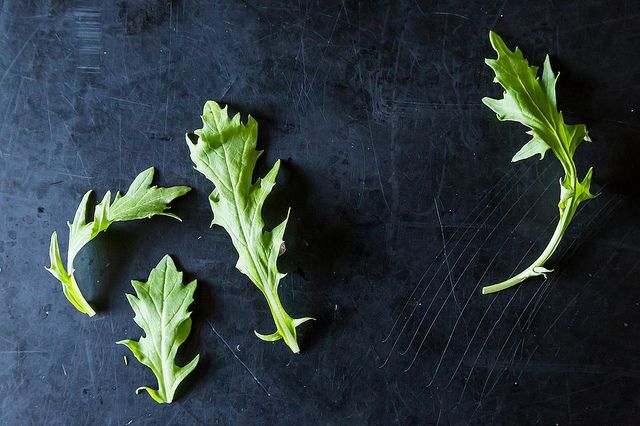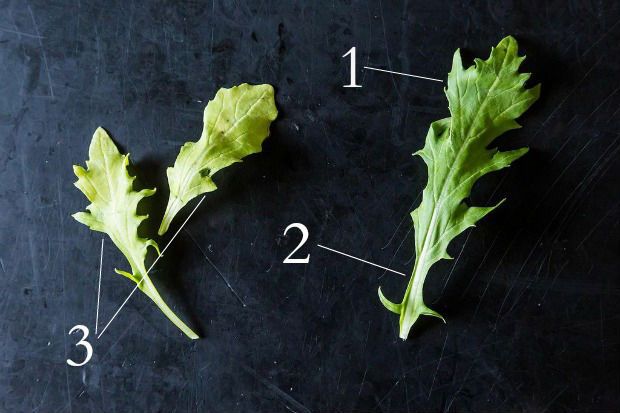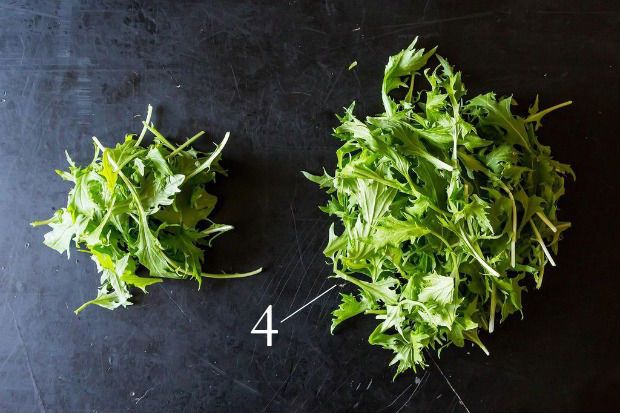Every week we get Down & Dirty, in which we break down our favorite unique seasonal fruits, vegetables, and more.
Today: We’re talking about another cool-weather-loving brassica while we wait for spring’s bounty. Get the true story on this feisty looking green, plus ideas for a week’s worth of mizuna-filled meals.

Mizuna likely originated in China, but since it's been cultivated for so many generations in Japan, it’s often thought of as a Japanese vegetable. This Asian green is another name-collecting vegetable; you might find mizuna labeled as kyona, Japanese mustard, potherb mustard, spider mustard, or California peppergrass. Like tatsoi, mizuna frequently shows up in salad mixes -- especially mesclun -- so there's a good chance you've already been introduced.
Fun cocktail party fact: mizuna's name means "water greens," which most associate with mizuna's juicy stems. But not Hiroko Shimbo -- in The Japanese Kitchen, she explains that mizuna is so named because it "is grown in fields that are shallowly flooded with water." Try to tell us this won't make you the life of your next party.

What to Look For
With its jagged saw-toothed leaves, mizuna looks like a vegetable with an attitude, so much so that you might expect to bite into an aggressively bitter green. That's not the case though, it's a total poser -- mizuna’s lacy leaves are actually very mild in flavor. They have a tiny bit of tang and a slight peppery bite, but an underlying subtle sweetness.
Look for mizuna with green glossy leaves (1) and bright white stems (2). Be sure to choose crisp bunches, and avoid any yellow (3) or slimy leaves like the plague. Mizuna tolerates cool weather well, so leaves grown in cold frames or hoop houses are available now. If you haven’t seen mizuna at your farmers market yet, hang tight -- you might find it at an Asian market in the meantime, but mizuna will likely show up for you later in the spring.
More: While you're at the market, look out for broccoli rabe, too.

How to Use Mizuna
Revisit last week’s tips to refresh your memory on storing and washing greens, and use mizuna like you would another versatile green -- add it to a salad, toss it in a stir fry, or a soup at the end of cooking. Mizuna holds up well to heat, but it does substantially shrink in volume. Just to be safe, buy double (4) what you think you’ll need. If you have larger leaves, remove their stems at the base of each leaf, as they'll take a bit longer to cook.
Mizuna's crunchy stems make it perfect for overnight pickling, and mizuna is right at home in pasta too. In Vegetables from Amaranth to Zucchini, Elizabeth Schneider uses mizuna two ways in one recipe: as a bed for soba noodles and radishes, and again in the tart tofu-mizuna dressing they're tossed with.
Want ideas for how to eat mizuna every day of the week? We've got those, too:
Saturday: Spicy Thai Beef Salad with Mizuna
Sunday: Chef Seth Caswell’s Gravlax with Tat Soi, Mizuna and Pickled Rhubarb Vinaigrette
Monday: Wok Sautéed Mizuna with Minced Chicken
Tuesday: Mizuna, Radish Pods and Turnip Ribbons Salad
Wednesday: Mizuna & Haricot Vert Salad with Crispy Potatoes, Purple Basil, Cherry Tomatoes & Stilton
Thursday: Salad of Grilled Shrimp & Wilted Mizuna Mustard Greens
Friday: Zuni Cafe’s Roasted Chicken with Bread Salad (Just swap mizuna for the other greens.)
Photos by James Ransom
Read More:
How to Wash Greens (Without a Salad Spinner)
All About Tempeh (plus a Mizuna Salad with Miso)
10 Recipes to Welcome Spring




See what other Food52 readers are saying.